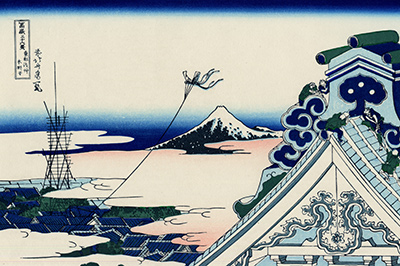Hokusai
Asakusa Hongan-ji temple in the Eastern capital Edo by Hokusai
Asakusa Hongan-ji Temple in the Eastern Capital Edo is a view of Mount Fuji from the Tsukiji Hongan-ji temple in Tokyo. The print is one of a series of woodblock prints called Thirty Six Views of Mount Fuji. Despite its name, the series however has 46 blocks, since ten were added at a later date to the series. Asakusa Hongan-ji Temple in the Eastern Capital Edo is the first among those added subsequently.
The picture shows the view from the temple, looking down on the city. Clouds are floating at a level just beneath the top of the temple dome. This shows how the temple towers over the rest of the city. Only the mountains in the distance appear to be a match. The city is shown below filled with rows of houses. Interestingly, someone is flying a kite from within the city, and it has soared up into the skies, much above the clouds, almost on par with the temple.
The temple architecture is shown with elaborate carvings. The actual temple is a Jodo Shinshu Buddhist temple located in Tokyo. This temple has a long history in which it was burnt down twice. Originally built 1617 in Asakusa, it was razed in a fire merely 40 years later. It was then moved to the current area and rebuilt. This temple too was levelled to the ground in 1923 by the Great Kanto earthquake. This is the temple that Hokusai knew and painted. A third temple was built again in 1934 and is still standing.
Katsushika Hokusai was a Japanese artist, renowned during the Edo period for his paintings, prints, and woodblocks. As a child, he worked in a bookshop and later as an apprentice to a wood carver. He studied wood block printing from Katsukawa Shunshō and published his first prints in 1779. Hokusai’s work was greatly influenced by Chinese art of the time. He was famous for his block prints and his series One Hundred Views of Mount Fuji is generally considered a masterpiece. Hokusai had extensive influence in art, and even inspired European artists. He also prompted the Art Nouveau movement in Europe.
